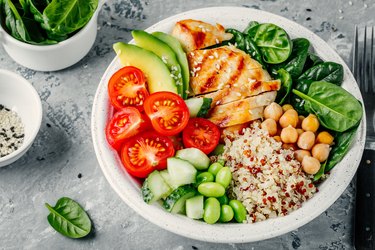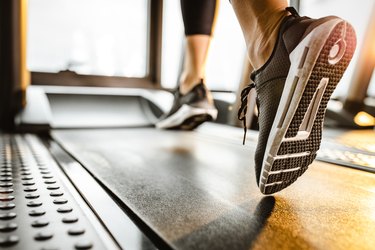
If you're looking to slim down your inner thighs, finding the right moves for leg day may seem like a big priority. But while certain exercises will help strengthen and tone your leg muscles, there's no workout move out there that will target inner thigh fat in particular.
That's because spot reduction simply isn't possible. When you work a specific body part such as your inner thighs, you don't directly affect the fat there, per the American Council on Exercise (ACE).
Video of the Day
Video of the Day
"It's wishful thinking to expect that you'll see the loss right at the most troubling area of your body," says Laura Giannone, RD, CDN. "Spot reduction (aka targeted fat loss), unfortunately, doesn't happen. Years' worth of research can support this, particularly for reduction in the abdominal and arm areas," she say.
But don't feel discouraged about your leg weight-loss goals: Any exercises you do will help you lose more fat while building more muscle, Giannone says. Not sure where to start? Here are six tips for how to lose weight in your inner thighs (spoiler: your whole body is involved), plus recommended exercises to help get toned, strong legs.
1. Start Tracking
First things first: You need to take in less than you burn — that is, you'll need to create a calorie deficit.
To do that, you'll determine how many calories you need daily to maintain your weight by using an online calculator or meeting with a dietitian. Then, subtract 500 to 1,000 calories, and use that number as your new daily calorie target in order to lose weight and fat, according to the Mayo Clinic.
Since one pound equals 3,500 calories, you'll set yourself up to lose 1 to 2 pounds per week.
Track the portions and calories of everything you eat to make sure you hit your daily calorie target. Remember, all of these pounds won't exit your thighs exclusively, but as your whole body shrinks, so too will your legs.
"Tracking calories and food doesn't have to be overwhelming or stressful though," Giannone says. "You can start by making small changes such as reducing blatantly large meals, ordering a half-portion when dining out and reducing obvious sources of sugar in your diet (think fruit juices, soda, alcohol)," she says.
Just make sure you're not over-doing it. Calorie intake should not fall below 1,200 a day in women or 1,500 a day in men, unless you're under the guidance of a medical professional, per Harvard Health Publishing.
"Far too often, clients will consume few calories in an effort to lose weight," Giannone says. "This can actually decrease their metabolic rate. And by doing so they can inadvertently wind up hampering their weight-loss efforts. Calories provide us with energy for every action in our body, from the energy required to merely walk into a room and sit in a chair to running a race," she says.
Related Reading
2. Eat to Lose

Once you've reduced your calories, you have to make sure the ones you are still taking in come from quality sources. Limit refined carbs, sugar and both saturated fats and trans fats, and add in more lean protein, fruits, veggies, whole grains and mono- and polyunsaturated fats.
What to Eat — and What to Avoid
Not sure where to get started with these dietary changes? Follow these strategies from Giannone:
- Always try to include a variety of food in your diet. If you eliminate entire groups of food you don't just cut calories, you also reduce your intake of vital vitamins and minerals.
- Opt for lower-calorie beverages. If you swap a flavored seltzer with zero calories every day in place of a 150-calorie soda, it'll save you 1,050 calories by week’s end.
- “Spice" your coffee instead of adding flavored creamer. Adding a pinch of cinnamon, apple pie spice or even a dash of vanilla extract can save calories with each cup. One ounce of flavored creamer has 75 calories, per the USDA.
- Bulk up your diet by choosing high-fiber fruits and vegetables. If you're craving sweet, choose ripened mango, apricots, plums or nectarines. If you're craving savory, snack on red, yellow and orange peppers or homemade baked kale chips.
3. Strengthen Up
Strength and resistance training are highly recommended because muscle mass increases metabolic rate. So, the more muscle you have (everywhere, not just your legs), the more calories you burn daily.
Cardio combined with resistance training led to better results for decreased body fat mass and increased lean muscle than just cardio alone, according to a study published in April 2014 in the Journal of Sports Sciences. And, resting metabolic rate may increase 7 percent after 10 weeks of resistance training, per a review in the July/August 2012 issue of Current Sports Medicine Reports.
If you're a strength-training beginner, start off with one to two sets of 12 to 15 reps for all major muscle groups with weights that tire your muscles by the end of the reps, per the Mayo Clinic.
"During your full-body workouts, I recommend compound movements such as squats, deadlifts, overhead presses, etc," says Max Gomez, ACE-certified fitness trainer. All these moves work several muscles at one time, he notes.
Related Reading
4. Schedule Leg Day
Although specific inner thigh exercises won't burn the fat there, they can help build stronger, more shapely legs by developing the inner thigh muscles. Toning your inner thighs also has health benefits: Those muscles help stabilize your hips and knees, which can prevent joint pain as you age, per ACE.
You know squats, lunges, and step-ups can target the whole leg, but wide-legged plié, sumo squats, inner thigh leg lifts and ball squeezes target the adductor muscles.
Related Reading
5. Complement With Cardio

"Cardio is one of those things that can really complement a well-planned workout routine when factored in appropriately," Gomez says. "The meat and potatoes of your workout will primarily consist of weight and resistance training in order to build muscle and trim fat, however, factoring cardio into your workout will help you burn extra calories."
Adults should do at least 150 to 300 minutes a week of moderate-intensity activity, or 75 to 150 minutes a week of high-intensity aerobic activity, to reap maximum health benefits, according to the U.S. Department of Health and Human Services (HHS). This activity should be spread throughout the week.
Cardio that works the legs will help tone inner thigh muscles as well as burn calories to help you lose fat. Get on the elliptical, take a jog or hike, go biking or try a plyometrics workout.
Related Reading
6. Add HIIT to the Plan
High-intensity interval training (HIIT) combines exercises done at high intensity for a short duration followed by a short recovery period. When you perform HIIT workouts, you push your cardiovascular and metabolic systems to their max potential, which may even lead you to continue to burn calories several hours after your workout, says Logan Shaw, ISSA Elite CPT.
HIIT workouts produced substantial positive changes in people with obesity, including cardiometabolic health, per an October 2016 study in British Journal of Sports Medicine. Short-term HIIT workouts can lead to a modest amount of body composition improvements without even losing weight, according to a June 2017 article in Obesity Reviews.
"An example of a HIIT workout would be something like an EMOM (every minute on the minute)," Gomez says. "With this, you'll do one exercise for a certain amount of reps and then do another exercise as an 'active recovery.' For instance, you may do 3 deadlifts and once you hit that rep count, you'll do burpees for the rest of the minute. Once the minute is up, you'll reset back to the 3-rep deadlift. You'll do this for 4 minutes or so, and then follow that similar format with other exercises," he explains.
Related Reading
- American Council on Exercise (ACE): "Spot Reduction: Why it Doesn't Work"
- Mayo Clinic: Counting Calories: "Get Back to Weight-Loss Basics"
- Harvard Health Publishing: "Calorie Counting Made Easy"
- Journal of Sports Sciences: "Aerobic Plus Resistance Training Was More Effective in Improving the Visceral Adiposity, Metabolic Profile and Inflammatory Markers Than Aerobic Training in Obese Adolescents"
- Current Sports Medicine Reports: "Resistance Training is Medicine: Effects of Strength Training on Health"
- Sports Medicine: "Effects of Resistance Training Frequency on Measures of Muscle Hypertrophy: A Systematic Review and Meta-Analysis"
- Mayo Clinic: "Strength Training: Get Stronger, Leaner, Healthier"
- American Council on Exercise (ACE): "Workouts for Inner Thighs: How to Strengthen Your Inner Thighs"
- U.S. Department of Health & Human Services: "Physical Activity Guidelines for Americans"
- British Journal of Sports Medicine: "Effects of High-Intensity Interval Training on Cardiometabolic Health: A Systemic Review and Meta-Analysis of Intervention Studies"
- Obesity Reviews: "The Effects of Hight-Intensity Interval Training vs. Moderate-Intensity Continuous Training on Body Composition in Overweight and Obese Adults: A Systematic Review and Meta-Analysis"
- USDA: "Coffee creamer, liquid, flavored"